Are you concerned about the security of your outswing door? In today’s world, where burglary and break-ins are unfortunately common occurrences, it is important to take measures to secure your home.
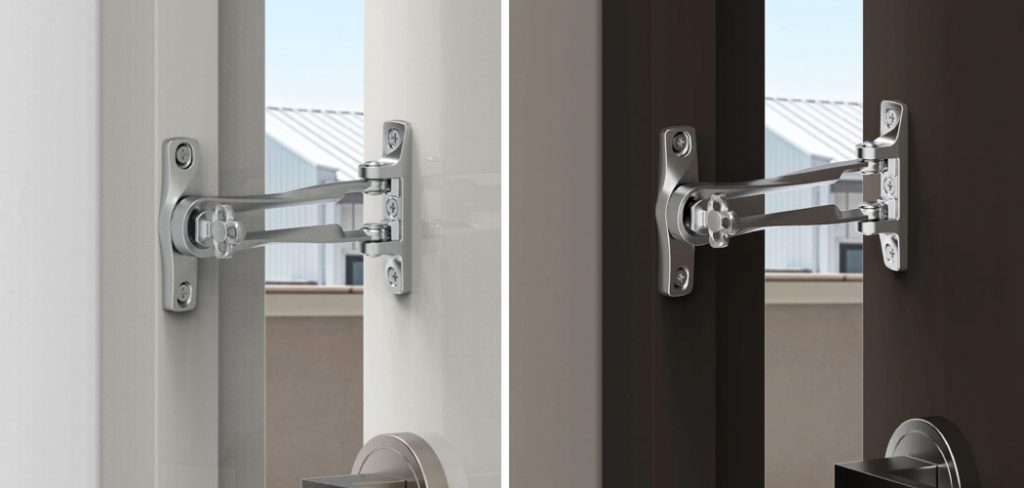
Securing an outswing door, while presenting unique challenges compared to its inswing counterparts, is crucial for enhancing the safety and security of a home or building. Outswing doors, which open outward, are often targeted by intruders due to potential vulnerabilities in their design and installation.
However, these doors can be fortified against unauthorized access with the right strategies and hardware. This guide will explore various effective methods to secure outswing doors, from choosing the right locks and reinforcement kits to employing additional security measures that provide peace of mind.
Whether you’re looking to upgrade the security of a residential home or a commercial property, understanding how to secure outswing door is an essential step in safeguarding any premises.
What are the Benefits of Securing an Outswing Door?
One may wonder if it is worth the effort and investment to secure an outswing door. The answer is a resounding yes! Here are some key benefits of securing your outswing door:
- Deter Intruders: By implementing effective security measures, you can discourage potential intruders from attempting to break into your property. This not only protects your home and belongings but also ensures the safety and well-being of yourself and your loved ones.
- Enhance Safety: Securing an outswing door can provide added protection against natural disasters such as strong winds and hurricanes. This is especially important for homes located in areas prone to severe weather conditions.
- Insurance Benefits: Some insurance companies offer lower premiums for homes with enhanced security measures. By securing your outswing door, you may be eligible for discounts on your home insurance.
- Peace of Mind: Knowing that your outswing door is properly secured can give you peace of mind, allowing you to feel more secure and comfortable in your own home or building.
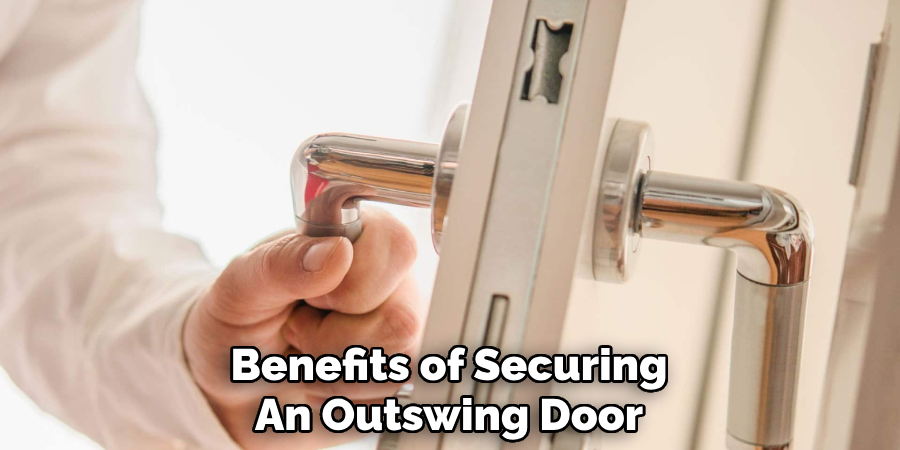
These are just some of the benefits of securing an outswing door. Now, let’s explore some effective methods to achieve a secure outswing door.
What Will You Need?
Before you begin securing your outswing door, gathering all the necessary tools and materials is important. Here are some items you may need:
- Locksets: Choose high-quality locksets that are specifically designed for outswing doors. These include deadbolts, keyless locks, and mortise locks.
- Reinforcement Kits: These kits are designed to help strengthen the door frame and prevent it from being forced open.
- Hinges: Consider upgrading to heavy-duty hinges that have longer screws for added security.
- A peephole or Door Viewer: Install a peephole or door viewer to see who is at your door before opening it.
- Security System: Consider installing a security system that includes sensors on your outswing door for added protection.
Now that you have all the necessary tools and materials, let’s dive into some effective methods to secure an outswing door.
10 Easy Steps on How to Secure Outswing Door
Step 1. Install a Deadbolt:
The first and most crucial step in securing an outswing door is to install a quality deadbolt lock. A grade 1 or grade 2 deadbolt provides a high level of security and is difficult for intruders to manipulate. Ensure the deadbolt extends at least one inch into the door frame.
Step 2. Upgrade to Security Hinges:
Traditional hinges can be weak points on outswing doors, making them vulnerable to attack. Upgrading to security hinges is a crucial step in fortifying your door. Look for hinges with non-removable pins or those designed with built-in locking mechanisms.
Security hinges are constructed to withstand force and ensure that the door cannot be removed even if the pins are compromised. Additionally, installing longer screws in the hinge plates can anchor the door more securely to the frame, making it harder for intruders to kick in or pry open the door.
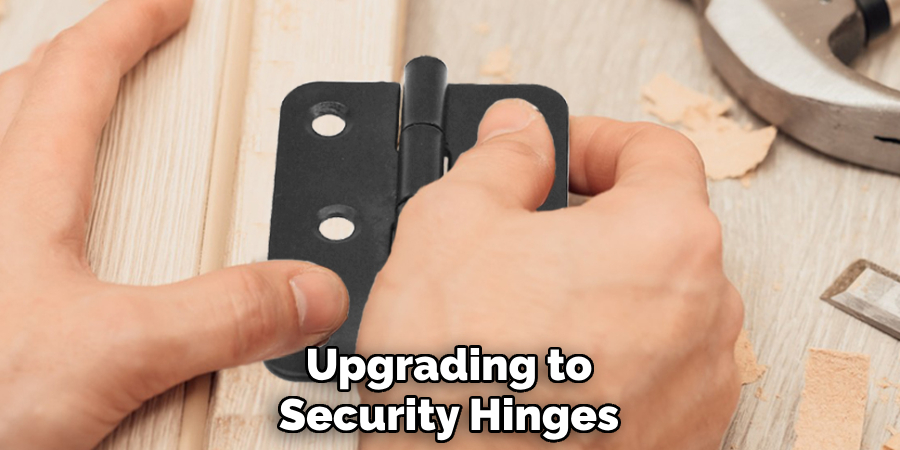
Step 3. Use a Door Reinforcement Kit:
A door reinforcement kit is another effective measure to enhance the security of your outswing door. These kits typically include a metal plate extending the length of the door jamb, reinforcing the area around the lockset and the hinges. This makes it significantly more difficult for intruders to open the door.
Additionally, some kits come with a door edge protector to shield the door itself from being split or kicked in. Installation is straightforward, usually requiring only basic tools, and offers a substantial upgrade in security strength.
Step 4. Install Door Wrap Around Plates:
Door wrap-around plates are an excellent addition to securing your outswing door. These metal plates encase the door at the lock area, providing extra reinforcement against forceful entry. They are particularly useful in preventing the door from splitting around the lock mechanism, a common entry method used by intruders.
Wrap around plates are available in various sizes and finishes to match your door and lockset aesthetics, making them a secure and visually appealing option. Installation is typically simple, with plates designed to fit around existing locksets and deadbolts, reinforcing the door without needing complete lock replacement.
Step 5. Add a Security Bar or Door Brace:
For those seeking an additional layer of protection, a security bar or door brace is a highly effective solution for outswing doors. These devices are designed to withstand substantial force, bracing your door against intrusions. Security bars can be installed at the base of the door, anchoring it to the floor, or they may span the width of the door, securing it to the walls on either side.
This physical barrier significantly reduces the likelihood of forced entry, making it an excellent choice for enhancing home security. Installation is usually user-friendly, and many security bars are adjustable, ensuring a perfect fit for your door.
Step 6. Consider a Security Screen Door:
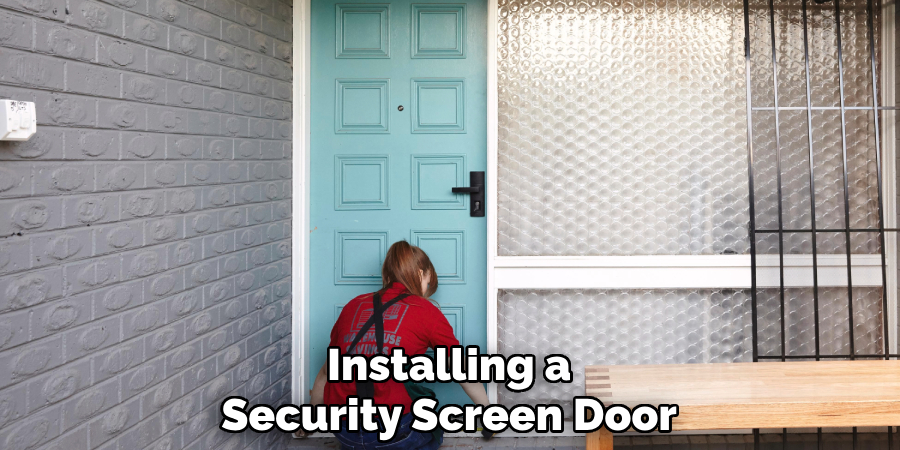
Installing a security screen door in front of your outswing door can provide an additional layer of defense. These doors are made from sturdy materials such as steel or wrought iron and are equipped with secure locks and tamper-resistant hinges. Not only do they serve as a physical barrier, but they also allow for ventilation and visibility without compromising security.
When selecting a security screen door, opt for one that meets your aesthetic preferences while offering the highest level of protection. Installation might require professional assistance to ensure it fits perfectly and functions as intended, further enhancing your home’s security posture.
Step 7. Install a High-Security Lockset:
Consider installing a high-security lockset for an additional layer of security on your outswing door. These locks come with features like pick-resistant cylinders, drill protection, and keys that cannot be duplicated without authorization. High-security locksets are designed to resist various forms of forced entry and manipulation, offering you peace of mind knowing your door is guarded by superior locking technology.
When choosing a lockset, look for one that is ANSI Grade 1 certified, indicating the highest level of durability and security performance. Installation may require replacing your current lock or making adjustments to the door, but the investment significantly enhances your door’s resistance to intrusion.
Step 8. Apply Window Film to Glass Panels:
If your outswing door features glass panels, applying security window film is a vital step in protecting your home. This film reinforces the glass, making it much harder to break or shatter, significantly delaying any attempt at forced entry. Security window films are available in clear or tinted varieties, allowing you to enhance privacy while maintaining natural light.
The installation process can be completed with minimal tools and is straightforward, making it a convenient yet effective security measure. This addition not only fortifies the door itself but also contributes to the overall security of your home.
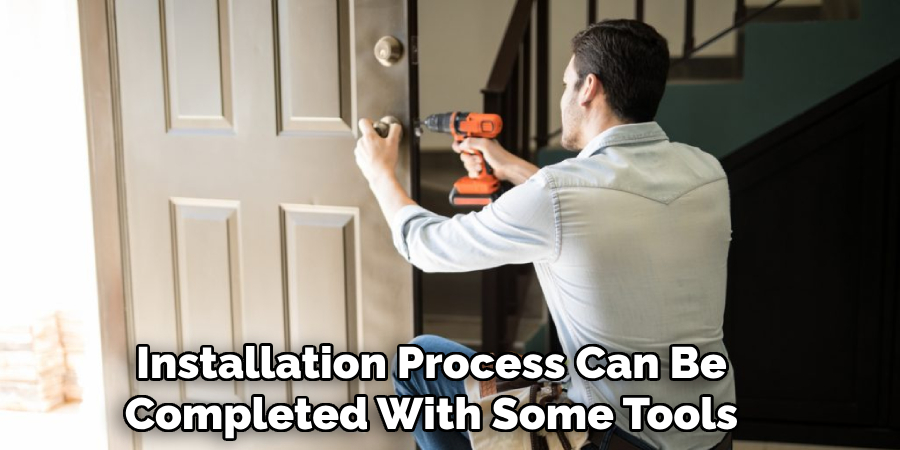
Step 9. Regular Maintenance and Inspection:
To ensure the continued effectiveness of your outswing door’s security features, regular maintenance and inspection are key. Over time, components such as locks, hinges, and frames can wear or become loose, potentially compromising the door’s integrity. Periodically check each security element for signs of damage or wear and promptly make any necessary repairs or replacements.
This includes tightening screws, lubricating locks, and hinges, and inspecting the door and frame for signs of forced entry attempts. By maintaining your door’s security measures, you not only extend their lifespan but also keep your home’s defenses optimal against potential intruders.
Step 10. Integrate Smart Security Devices:
Incorporating smart security devices into your outswing door setup introduces a new layer of protection and convenience. Smart locks offer keyless entry options and the ability to lock or unlock your door remotely via a smartphone app. Doorbell cameras and security cameras provide real-time monitoring capabilities and can alert you to suspicious activity around your door.
Additionally, integrating these devices with a home security system can immediately notify you and the authorities of a breach. Installation of smart devices varies in complexity but often includes wireless options for ease of setup.
By following these steps and implementing additional security measures, you can significantly enhance the strength and effectiveness of your outswing door.
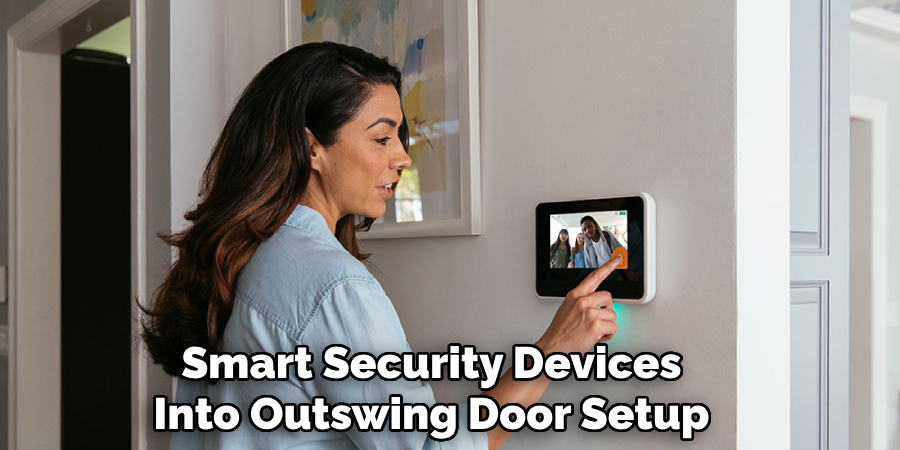
5 Additional Tips and Tricks:
- Install Security Hinges: To prevent your outswing door from being removed from the outside, consider installing security hinges with non-removable or locking pins. This makes it difficult for intruders to tamper with or remove the door hinges.
- Use a Door Barricade or Security Bar: A door barricade or security bar can be used to reinforce outswing doors from the inside. When in place, it can prevent the door from being forced open, providing an extra layer of security.
- Reinforce Door Frames: Use a door frame reinforcement kit to strengthen the frame. These kits come with metal strips that you can install to make the frame more resistant to forceful entry.
- Upgrade to High-Security Locks: Replace standard door locks with high-security locks that are pick-resistant and bump-proof. High-security locks often come with reinforced strike plates and longer screws, making the door much harder to kick in.
- Install a Security Screen or Storm Door: Adding a security screen or storm door in front of your outswing door can provide an additional barrier to entry. These doors are typically made of sturdy materials with secure locks, adding another layer of protection against break-ins.
With these additional tips and tricks, you can further enhance the security of your outswing doors and feel more secure in your home.
5 Things You Should Avoid When Securing Outswing Doors
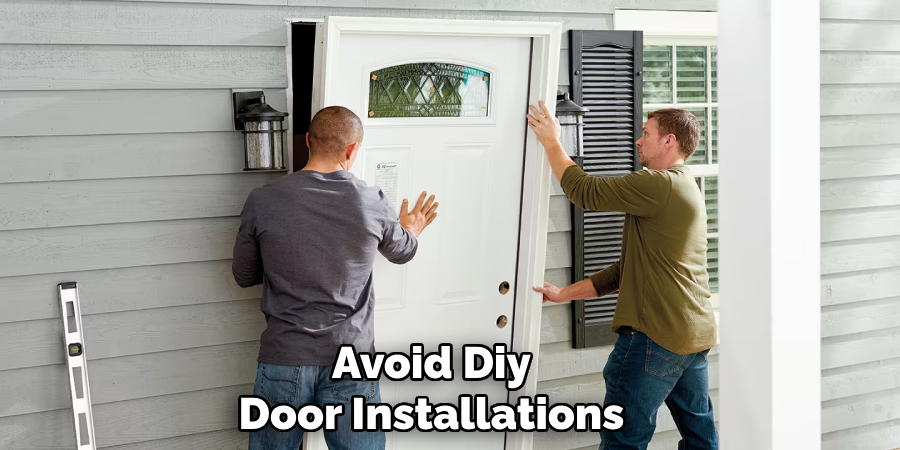
- Neglecting the Door’s Material and Quality: Opting for a cheaper, low-quality door can undermine your security efforts. Avoid using materials that are easy to breach. Instead, select a sturdy, durable door that can resist attempts at forced entry.
- Ignoring the Importance of Proper Installation: Even the best security features can only succeed if the door is correctly installed. Avoid DIY installations if you’re not experienced. Ensure that professionals install the door to guarantee that all security measures function as intended.
- Overlooking the Deadbolt: Using short screws in the Deadbolt strike plate is a common mistake. Avoid this by ensuring that the deadbolt is installed with long screws that reach the door frame’s studs, thus providing better resistance against force.
- Forgetting to Secure the Hinges: Given that outswing doors have their hinges on the outside, it’s crucial not to neglect hinge security. Avoid using standard hinges that can be easily tampered with. Instead, opt for security hinges or hinge pins that prevent the door from being lifted out.
- Skimping on Additional Security Features: Relying solely on the door’s lock is insufficient. Avoid the mistake of not adding extra security measures such as door sensors, alarm systems, or a peephole/camera. These features provide added security by alerting you to potential intruders and allowing you to monitor your door.
By avoiding these common pitfalls, you can significantly enhance the security of your outswing door and ensure that your home remains a safe sanctuary.
How to Lock a Door Without a Lock That Opens Outward?
If your outswing door does not have a lock, there are still ways to secure it. Here are three methods you can use:
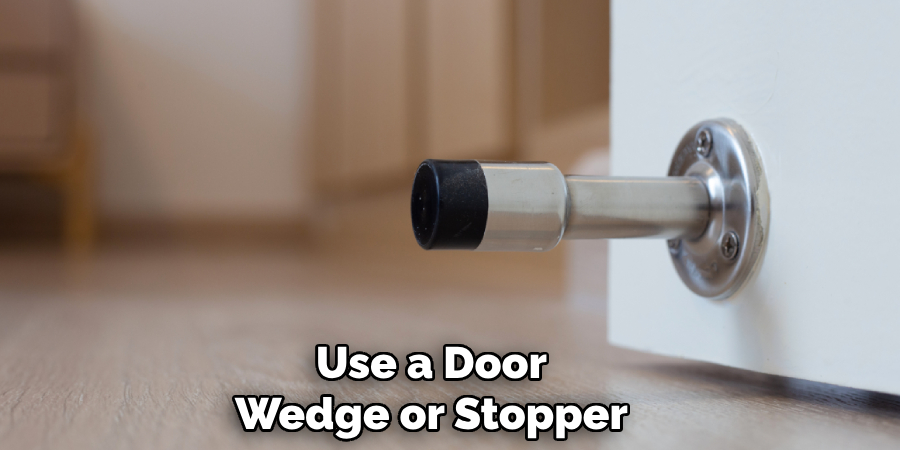
- Remove the Door Handle and Install a Deadbolt: If your outswing door has a handle but no lock, consider removing the handle and installing a deadbolt in its place. This provides an extra layer of security by preventing the door from being opened even if the handle is turned.
- Install a Floor Bolt: A floor bolt can be installed on the bottom of your outswing door, preventing it from opening when engaged. This method is useful if you don’t want to modify the existing hardware on your door.
- Use a Door Wedge or Stopper: Placing a door wedge or stopper under your outswing door can prevent it from opening, even if the handle is turned. This method is not as secure as the other options but can serve as a temporary solution in a pinch.
By utilizing these methods, you can lock an outswing door without an existing lock and provide an extra layer of security for your home. Remember to always prioritize safety and choose the best methods for securing your specific door type.
Which is Better Inswing or Outswing Door?
Both inswing and outswing doors have their advantages and disadvantages. Ultimately, the better choice depends on your specific needs and circumstances. Consider these factors when deciding between an inswing or outswing door:
- Space: Outswing doors are ideal for small spaces as they do not take up any interior space when opened. Inswing doors, on the other hand, require clear space in front of them to fully open.
- Security: Outswing doors are generally considered more secure since the hinges are located on the inside and cannot be tampered with from the outside. However, inswing doors can also be made secure with proper installation and additional security measures.
- Weather Resistance: Outswing doors are better at keeping out wind and rain, as their design prevents water from seeping in. Inswing doors may have a gap at the bottom that can allow water to enter during heavy rainfall.
- Aesthetics: Both inswing and outswing doors come in various styles and designs, so it ultimately comes down to personal preference.
Consider these factors carefully when choosing between an inswing or outswing door for your home. Remember, the best door is one that meets your needs and provides sufficient security for your household. So, make an informed decision and prioritize safety when it comes to choosing the right door for your home.
Conclusion
How to secure outswing door demands a comprehensive strategy that extends beyond simple lock installation. From selecting high-security locks to ensuring the door’s material and installation are of the highest quality, each measure plays a critical role in fortifying your door against potential intruders.
It’s crucial to avoid common security oversights, such as neglecting the strength of the door material, improper installation, ignoring hinge security, and relying solely on basic lock mechanisms.
Additionally, considering unconventional methods like floor bolts or deadbolts can provide an extra layer of security for doors without traditional locks. Ultimately, choosing between an inswing and an outswing door depends on factors like space, security, weather resistance, and aesthetics.
However, with the right precautions and enhancements, an outswing door can offer a high level of security and peace of mind. By understanding the vulnerabilities associated with outswing doors and addressing them with effective security measures, homeowners can significantly enhance their home’s safety and deter unauthorized entry
About
Safety Fic is a distinguished figure in the world of Diy design, with a decade of expertise creating innovative and sustainable Diy solutions. His professional focus lies in merging traditional craftsmanship with modern manufacturing techniques, fostering designs that are both practical and environmentally conscious. As the author of diy, Safety Fic delves into the art and science of Safety Fic-making, inspiring artisans and industry professionals alike.
Education RMIT University
(Melbourne, Australia) Associate Degree in Design (Safety Fic) Focus on sustainable design, industry-driven projects, and practical craftsmanship. Gained hands-on experience with traditional and digital manufacturing tools, such as CAD and CNC software.
Nottingham Trent University
(United Kingdom) Bachelor’s in diyfastly.com and Product Design (Honors) Specialized in product design with a focus on blending creativity with production techniques. Participated in industry projects, working with companies like John Lewis and Vitsoe to gain real-world insights.
Publications and Impact
In diy, Safety Fic his insights on indoor design processes, materials, and strategies for efficient production. His writing bridges the gap between artisan knowledge and modern industry needs, making it a must-read for both budding designers and seasoned professionals.
